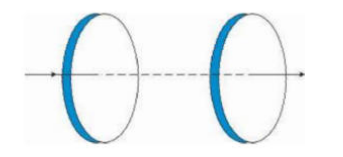Describe schematically the equipotential surfaces corresponding to - a field that uniformly increases in magnitude but remains in a constant (say, z) direction.Solution in Punjabi
Step by step video & image solution for Describe schematically the equipotential surfaces corresponding to - a field that uniformly increases in magnitude but remains in a constant (say, z) direction. by Physics experts to help you in doubts & scoring excellent marks in Class 12 exams.
Topper's Solved these Questions
Similar Questions
Figure 8.6 shows a capacitor made of two circular plates each of radius 12 cm, and separated by 5.0 cm. The capacitor is being charged by an external source (not shown in the figure). The charging current is constant and equal to 0.15A. Calculate the capacitance and the rate of change of potential difference between the plates. :
 02:41View Solution
02:41View SolutionAnswer the following questions regarding earth’s magnetism:A vector needs three quantities for Its specification. Name the three Independent quantities conventionally used to specify the earth’s magnetic field.
06:18View SolutionDraw 3 equipotential surfaces corresponding to a field that uniformly increases in magnitude but remains constant along positive Z-direction. How are these surfaces different from that of a constant electric field along Z-direction ?
04:50View SolutionDescribe schematically the equipotential surfaces corresponding to (a) a constant electric field in the z-direction, (b) a field that uniformly increases in magnitude but remains in a constant (say, z) direction, (c) a single positive charge at the origin, and (d) a uniform grid consisting of long equally spaced parallel charged wires in a plane.
03:26View SolutionDraw three equipotential surfaces corresponding to a field that uniformly increases in magnitude but remains constant along z-direction. How are these surfaces different from that of a constant electric field along z-direction?
04:26View SolutionDescribe schematically the equipotential surfaces corresponding to (a) a constant electric field in the z-direction.
04:29View SolutionDescribe schematically the equipotential surfaces corresponding to (b) A field that uniformly increases in magnitude but remains in a constant (say, z) direction.
04:29View SolutionDescribe schematically the equipotential surfaces corresponding to A field that uniformly increases in magnitude but remains in the same (say Z) direction
04:07View SolutionDescribe schematically the equipotential surfaces corresponding to
A field that uniformly increases in magnitude but remains in the same (say Z) directionView SolutionDescribe schematically the equipotential surfaces corresponding to
a. a constant electric field in the z-direction.
b. a field that uniformly increases in magnitude but remains in a constant (say,z) direction.
c. a single positive charge at the origin, and
d. a uniform grid consisting of long equally spaced parallel charged wires in a plane.View SolutionDescribe schematically the equipotential surfaces corresponding to (a) a constant electric field in the z-direction, (b) a field that uniformly increases in magnitude but remains in a constant (say, z) direction, (c) a single positive charge at the origin, and (d) a uniform grid consisting of long equally spaced parallel charged wires in a plane.
View SolutionDescribe schematically the equipotential surfaces corresponding to
(a) a constant electric field in the z-direction,
(b) a field that uniformly increases in magnitude but remains in a constant (say, z) direction,
(c) a single positive charge at the origin, and
(d) a uniform grid consisting of long equally spaced parallel charged wires in a plane.06:56View SolutionDescribe schematically the equipotential surfaces corresponding to
(a) a constant electric field in the z-direction,
(b) a field that uniformly increases in magnitude but remains in a constant (say, z) direction,
(c) a single positive charge at the origin, and
(d) a uniform grid consisting of long equally spaced parallel charged wires in a plane.View SolutionDescribe schematically the equipotential surfaces corresponding to (a) a constant electric field in the z-direction, (b) a field that uniformly increases in magnitude but remains in a constant (say, z) direction, (c) a single positive charge at the origin, and (d) a uniform grid consisting of long equally spaced parallel charged wires in a plane.
View SolutionDescribe schematically the equipotential surfaces corresponding to
(a) a constant electric field in the z-direction,
(b) a field that uniformly increases in magnitude but remains in a constant (say, z) direction,
(c) a single positive charge at the origin, and
(d) a uniform grid consisting of long equally spaced parallel charged wires in a plane.04:15View SolutionDraw 3 equipotential surfaces corresponding to a field that uniformly increases in magnitude but remains constant along Z-direction. How are these surfaces different from that of a constant electric field along Z-direction ?
05:55View Solution

